I posted a new poll just a few days ago called Do you take leftover pho to go in a takeout container? Of all the polls that I run on LovingPho.com so far, I've never had a strong reason to write something about it right away. This is the first.
As shown in the screen snapshot of the result at right taken as of 07-25-14, people who take the poll are saying the following:
- 38% say they never take leftover pho to go in a container, even when they can't finish,
- 19% (14% + 5%) say they do it when they can't finish their pho in the restaurant,
- 43% say they haven't a clue what we're talking about.
Here's the thing. Vietnamese rarely take home leftover pho from restaurants. Even at home, we don't save leftover pho for later either. The fact is, except for a few real hungry individuals, most Vietnamese do not finish their bowls to empty, at home or in restaurant. Most people eat the banh pho noodle, the meat and other stuff in the bowl, and about 1/2 to 2/3 of the broth, and then leave the rest. Most of the 1.3 or so billion Chinese do not empty their bowls either; they eat all the noodle and things but not all the broth regardless of how great the broth is. It's just not the way.
There are a few reasons for this, but the primary one is most noodles when served in broth come with a ticking time clock. Pho and noodle shops serve them fast to waiting customers because they want to minimize the time the noodle sits in the broth before the customers start eating. We all know that noodle turns to mush if left untouched for too long. It's the same reason why you wouldn't eat a bowl of pho after it sits for a few hours. And the same reason why many refuse to eat pasta cooked much beyond al dente. The noodle gets bloated and turns mushy.
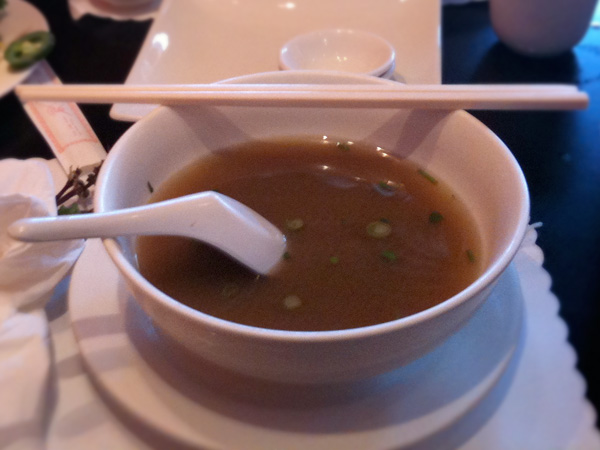 If I were to do this exact poll strictly in Vietnamese for the Viet market, it wouldn't make any sense. From the early days of pho in the U.S. until even now, many Viet people sort of chuckle when seeing someone requesting for a takeout cup, then pour everything from the bowl into the cup. But let me make absolutely clear here that it's not my intention to be snobbish or condescending. This is not about being right or making fun of others. It's about etiquette, if you will, and it's about understanding and preventing culture clash. Obviously, people have the right to enjoy food their own way (witness most of us Americans eat sushi, is there right or wrong anymore?) My point is, as pho becomes more mainstream, pho will belong to the mainstream as well. And if someone wants to take home leftover pho, reheat it and eat the mushy rice noodle, then it's his or her choice.
If I were to do this exact poll strictly in Vietnamese for the Viet market, it wouldn't make any sense. From the early days of pho in the U.S. until even now, many Viet people sort of chuckle when seeing someone requesting for a takeout cup, then pour everything from the bowl into the cup. But let me make absolutely clear here that it's not my intention to be snobbish or condescending. This is not about being right or making fun of others. It's about etiquette, if you will, and it's about understanding and preventing culture clash. Obviously, people have the right to enjoy food their own way (witness most of us Americans eat sushi, is there right or wrong anymore?) My point is, as pho becomes more mainstream, pho will belong to the mainstream as well. And if someone wants to take home leftover pho, reheat it and eat the mushy rice noodle, then it's his or her choice.
The poll so far surprises me in 2 areas:
- I would never expect 19% of people (almost one in five) take home their leftovers. I was expecting much lesser number.
- And I would never expect 43% aren't sure what the "issue" is. Now you know, but sorry you can't retake the poll 😉
So what's your take on this? I think I've just tainted the poll.
Read my post on Leftover Pho: A Better Alternative.

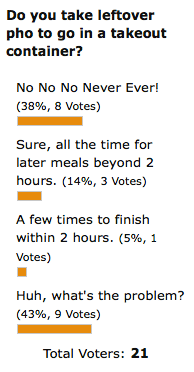
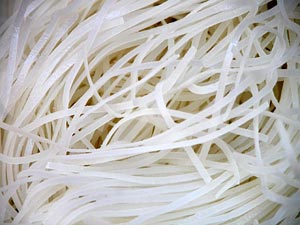
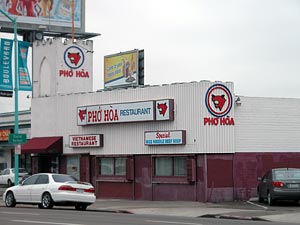
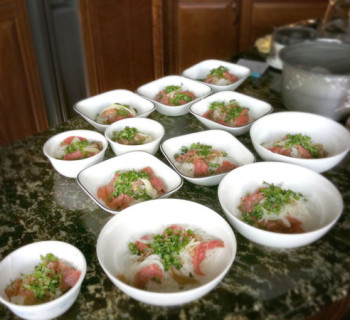
I’ve found that if you separate the noodles from the broth, then refrigerate, the pho is good to last 2 days at most. This afternoon I heated up last night’s left overs from Bambuza Vietnamese and it was pretty good. Make sure to microwave the broth before you microwave the noodles. Then combine the two!
@Greg: Good procedure to get the best quality you can get for leftover pho. If one really cares about maximizing leftover pho quality after you leave the restaurant, then I would suggest taking an extra step to separate the noodle out of the broth at the restaurant. This is the reason why restaurants always package banh pho noodle separately from the broth in takeout orders. From the beginning of pho in North America in the 70’s until now, no customers ever had to request separating banh pho and broth. Even though it’s not the cheapest way to sell takeout pho, it’s just done for you because it’s the best way to preserve the best quality for when a customer actually has the chance to enjoy it later. Cheers.
Good point Cuong! The restaurant I got my pho from did separate it, that made reheating a little easier. One problem I had though is that the noodles were a giant rock hard clump the next day. Any recommendations on how to get them to separate without tearing them into shreds?
Hey Greg: That’s exactly what you get if you don’t consume rice noodle as soon as it’s prepared and served. The proper way to serve banh pho rice noodle is to blanch it in boiling water just before serving, not 15 minutes before, not half an hour before.
Rice noodle is not as hardy as wheat noodles like spaghetti, and when cooked hot and let sit, it will take the shape of its container. Once cooked, the only effective way that I know to re-therm banh pho without ripping and shredding it as you described is to quickly reboil it (attention on quick) or heat it up in a commercial steamer (again paying attention to time to not overcook).
When your pho bowl is served at the table, whether at home or in restaurant, the action of stirring it up to eat basically prevents the noodle from caking at the bottom of the bowl. For restaurants that didn’t serve pho correctly or care about quality, they blanch the noodle too far in advance and let it sit for too long before pouring the broth and serve.
I don’t claim to have to best solution for leftover pho (I just avoid it), but it seems that for the best quality possible, first separate the banh pho from the broth (as soon as possible or in the case of takeout, don’t mix to begin with). Then do not let hot banh pho clump up in its container by, again as soon as possible, release it from its container and air it out. This separates the noodle strands and allows cool air through to prevent caking or clumping. It all depends on when you plan to eat it.
There’s a reason why takeout sushi is not very practical, and those who actually buy takeout sushi do know that after a certain time has past, it’s best to just toss it. Some foods are just not meant for prolonged holding in containers and/or go through multiple hot and cold phases. You either have to cool food down fast for storage, or eat it soon after being served.
I focus on eating all of the perishable stuff at the restaurant, the noodles, the sprouts, the beef…then I take home the leftover broth( and sriracha)! I usually have a lot left. Then I throw that on the stove, boil it, and add NEW NOODLES! I buy rice noodles from the store for so cheap. Sometimes I’ll go all out and add more sprouts, meat, jalapenos, etc. But mostly I’m just excited to get more pho broth!
But yeah, I do get weird looks from the waitresses.
Hey Sarah: That’s an interesting way to do it; maybe the best alternative under the circumstance. Again I wouldn’t do it but if you must…
I think it’s really a personal preference to eat all the solids (what you referred to as “perishable stuff”) but I just want to point out that everything in a pho bowl is meant to be eaten and enjoyed together in one sitting. It’s what makes pho what it is and why people love pho so much.
The vast majority of Asians do not take leftover broth home because:
1) By the time you finish with the noodles and meat in the bowl, what liquid and particles you have left no longer taste like fresh pho broth even if you reheat it; the taste profile has been vastly changed from what pho broth was (you know, all the stuff that came out of the meat, the lime, the noodle itself, all the sauces you added, and the sprouts and Thai basil, etc.), and
2) Many Asians think of leftover broth (whether you’re talking pho, Japanese ramen, or any Chinese noodles in broth) as akin to dishwashing water, and as such there is not even a remote possibility to re-eat it. Regardless, there is no way you can eat all solids in a bowl of pho. There are always bits and scraps of noodle strands, meat, vegetables and all kinds of particles floating in the broth, swelling into mush when you finally get to it later.
Maybe it’s an Asians versus Westerners thing, but that’s what the weird look from the waitress is about.
A better suggestion I have is, since you don’t mind the expense and trouble of getting new noodle and other ingredients, why not spend a few more dollars at the restaurant to buy extra broth for take out. This way you can fully enjoy your pho both at the restaurant and at home too!
I brought home the leftover broth and have my own noodles and beef to add to it later!
Seems silly to waste it
@Brianna Ingram: You’re one among the 41% (people from the poll above) who do this. It’s still not for me, though adding your own noodle and new ingredients later is the right move. If it’s that good, then of course it’s silly to waste it. Thanks for sharing your love for pho!